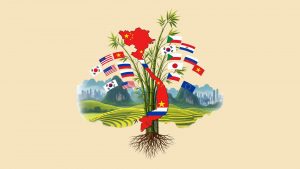Last week saw a major diplomatic summit in Johannesburg – or did it? Leaders and representatives of Brazil, Russia, India, China and South Africa, and from forty-one partner nations, assembled for the 15th annual meeting of the BRICS group. But, opinion in western media is divided on the true significance of the event. Did it mark the debut of a viable bloc for a newly multipolar world – or was it just an anti-western gabfest that need not trouble governments in Washington, London and Brussels?
Your view of the BRICS tends to depend on how invested you are in the upkeep of the post-1945 liberal international order: the summit generated an oddly hostile response from talking heads in the transatlantic foreign policy world. Pankaj Mishra, ordinarily no fan of the West, nevertheless typified the mood when, writing in the Washington Post, he called the BRICS an ‘assortment of princelings, autocrats, demagogues, and war criminals … little more than a meaningless acronym.’ But we must remember that in international relations, just as in life, contempt most often masks insecurity. The unipolar moment, when America and its allies could dictate global policy choices, is over. Much of the world dislikes western preening, and disputes its claims to leadership. Existing international structures increasingly look like yesterday’s men: in the Asian Century, the G7 has only one Asian member, rapidly ageing Japan. For those who like to speculate about a post-western world, the meeting in Jo’burg has taken on totemic importance. So who are the BRICS? What do they want? And where are they headed?
The BRICS began life in 2001, as a handy acronym created by Jim O’Neill, a Goldman Sachs analyst, in a paper about the shape of the world economy in 2050. Originally, the term only referred to Brazil, Russia, India, and China, and was little more than a neat bit of writing to promote an investment fund that Goldman closed in 2015. But it struck a chord, and the first summit of the original BRIC powers was held in 2009. In 2010, South Africa was added to the group as a nod to Africa’s slow but inexorable march to global prominence.
Collectively, the BRICS have enormous potential: they represent 50.59% of the world’s population, and 36.6% of its GDP. However, when we unpack these numbers the reality becomes a little less certain. 70% of the economic heft of the BRICS comes from China alone; the rest of the bloc are comparative laggards. Unlike the G7, the BRICS can struggle to find a common purpose: China and Russia are firmly committed to competition with the west, while India, a raucous if troubled democracy, seeks to establish itself as a non-aligned third pole in global affairs. Brazil and South Africa are, in the words of The Economist, ‘geopolitical swingers’ happy to play all sides to get what they want.
But the BRICS face a serious fundamental issue – what, exactly, are they for? Most comparable organisations have a unity of purpose, or a vague shared heritage, to fall back on. The G7 march in ideological lockstep, as liberal democracies; the members of the Shanghai Co-operation Organisation all border one another. But the same isn’t true of the BRICS: they were first lumped together by a bank. Little unites the bloc except (perfectly understandable) frustration with the existing international order; but they have yet to articulate a convincing alternative. The addition of new members like Argentina, Saudi Arabia, Iran and Ethiopia – none exactly a byword for fiscal prudence, transparent governance and open society – risk making the BRICS look more like a rogue’s gallery than a thriving multilateral organisation: at least, under western eyes. (That said, one can only call getting Saudi Arabia and Iran into the same organisation the deftest of diplomatic manoeuvres). Nor are the BRICS guaranteed to be tomorrow’s economic behemoths.
All five founding members face serious economic, political, demographic and environmental challenges:
- Brazil holds 40% of the world’s tropical forests, and 20% of its fresh water, in the vast Amazon basin. But the ‘lungs of the earth’ are under threat: 20% of the Amazon rainforest has been cut down in the last fifty years, with massive global implications. Despite decades of growth, much of the country remains desperately poor, with gains disproportionately going to the top 0.1%. Government is weak, and cycles between far-right and far-left populism. Crime is high – Brazil has the highest absolute number of annual murders, nearly three times that of the US. As impressive as it might have looked in 2001, when the acronym was coined, the intervening decades have not provided much hope for Brazil’s future.
- Russia, under Vladimir Putin, has become an authoritarian kleptocracy. Life expectancy is down year-on-year, alcoholism is rife, and poverty remains stubbornly entrenched. An invasion of Ukraine in early 2022 has become a slogging match and proxy war with NATO that shows little sign of being resolved. It has not, however, made Russia an international pariah, as the western powers had hoped: sanctions have backfired, and Russia registered moderate GDP growth in 2022-2023. Trade with China is up substantially, although the ‘unlimited partnership’ announced just before the war began has perhaps not bloomed as much as Moscow wanted. Russia has begun buying weapons and munitions from Iran and North Korea, both out of the reach of western sanctions, and will be able to pour money, steel and bodies into the Ukrainian war longer than NATO can continue propping up Kyiv. Elsewhere, Russia remains a significant player in world trade. India continues to buy and refine Russian oil, often sending it back on to global markets. Neutral middle powers across Asia, like Kazakhstan and Malaysia, have also kept trading. Russia’s influence across Africa has never been greater. Likewise, Russia’s dominance of physical commodities – oil, gas, gold, timber, wheat, and especially nitrogen-based fertilisers – lends it serious hard power, and make it globally indispensable. Those who confidently dismissed Russia as ‘a gas station with an army attached … [and] incredibly unimportant to the world economy’ in 2021 and 2022 have had to eat their words. The rolling cost of living crisis, driven by energy and food inflation, and the struggle of ordinary people to live last winter, has been a salutary reminder that we cannot escape reality. For now, the highly-financialised service economies of the west post higher nominal figures than Russia – but you can’t eat a spreadsheet. As the crisis decades of the 2020s and 2030s continue to bite, Russia may paradoxically become more powerful, precisely because its economy is based on tangible goods. As much as some in the west might dream otherwise, Russia is down, but not out.
- India is the most promising of the BRICS in the long term. It has averaged a 7% annual growth rate, and is the one of the few major world economies not facing demographic collapse. Indeed, it is a young country: more than half the population are under 25. It is on a decades-long bull run, and is forecast to overtake Germany and Japan to become the world’s third-largest economy as soon as 2030. It recently marked an enormous scientific triumph with a successful moon mission. However, it is starting from a low base: average income is barely $2000 a year, 21.9% of the population live below the poverty line, and 28% of its 16-24 year olds are unemployed. Hygiene and sanitation remain persistent issues – even though 99% of the population have access to running water, it is not generally considered safe to drink. The government declared the country ‘open defecation free’ in 2019, but as much as 15% of the population continue the practice, with deleterious consequences for public health. Globally, India treads a fine line as a neutral democracy. It has never overcome its Cold War-era suspicions of the US, and a much-ballyhooed alliance has come to naught, as India prefers to engage with the world on its own terms rather than as an American satrapy. It is something of an awkward partner in the BRICS – while historically close to Russia, India has in the last three years been locked in a series of deadly border disputes with China. It trades little with Brazil, and has a complicated relationship with South Africa over the status of Indians there. Overall, India combines African demographics with Asian growth rates. Its future is sometimes uncertain, but greater wealth, and much greater global influence, are all but assured.
- China’s rise to wealth and power is the defining story of the last fifty years. In less than a lifetime, China has pulled itself up from third-world poverty to first-world status, and come to dominate global manufacturing across dozens of sectors, from shipbuilding to rare-earth processing. Beginning with low-end production, ‘made in China’ is now just as likely to mean electric cars, 5G tech, and cutting-edge artificial intelligence. But now, the economy is beginning to slow: the greatest bull run in economic history – 40 years of 10% annual growth – is over. However, western crowing about an imminent collapse is overblown: the Chinese economy is still likely to post 4-6% annual growth rates for the next decade, something Britain and the EU could only dream of. China’s challenges are certainly unique – this month, its economy tipped into deflation, at the moment that the rest of the world is grappling with inflation. It has too many houses, not too few; too much infrastructure, not too little (to be frank, to someone watching from Scotland or London, these seem like nice problems to have). But other issues are familiar to western observers, from the troubles of their own societies. Its young people – especially its would-be elite graduate class – appear to be increasingly disaffected. Marriage rates have plummeted, as have birth rates: indeed, the birth rate in China has halved in just seven years. Despite the repeal of the one-child policy, Chinese families seem reluctant to have more kids – in large part because China is one of the most expensive places on earth to raise a child – and the total lifetime fertility rate is just 1.09 children per woman – one of the lowest in the world. Environmental issues remain a serious concern, and even though it is pouring massive resources into renewable energy – potential capacity for solar, wind and nuclear outstrip the rest of the world put together – China is still the world’s largest consumer of coal, and will be for some time to come. Global relations are complicated: China has been on a highly successful charm offensive in the global south, but relations with the US have never been worse. There have been a rash of triumphalist pieces in western media recently, declaring the arrival of ‘peak China’, or predicting its imminent ‘Japanification’. But while China undoubtedly faces challenges, only a fool would write it off completely. It may be that, to preserve order and reduce the risks of a hard landing, the Chinese economy is being run cold, as opposed to the American strategy of running hot (or the British strategy of running it into the ground). However, with analysts increasingly unable to access vital data, and with fewer businessmen, journalists, diplomats and observers on the ground than ever before, the simple truth is that we have no reliable idea of what is happening, or will happen, in China. Chinese interests run on a longer time-scale than the hyperactive attention spans of western pundits will allow, and encompass a different set of priorities. This is always worth bearing in mind. Those breaking out the champagne at the thought of Japan Redux may come to regret their haste. Forces have been set in motion by China’s rise that will not be easily derailed.
- South Africa is the odd one out in the BRICS. While it may have seemed a promising bet in 2010, it has only sunk into dysfunction since then, under the increasingly chaotic rule of the ANC. Corruption is endemic. Major cities frequently go without electricity as the state energy firm, ESKOM, fails to maintain the grid or plan for demand surges. Thieves have stolen two thirds of the overhead cables from the national railway network, and have even managed to pull up the tracks for scrap metal. Violent crime remains high, particularly armed robbery and murder. Racial strife has returned, with the white minority subject to government discrimination, egged on by opposition politicians. There have been a string of brutal attacks against Afrikaner-owned farms. Few analysts today would point to South Africa as a thriving emerging economy. While it is rich in natural resources – South Africa is a leading producer of chrome, platinum, titanium, iron ore, gold, diamonds, and a dozen of the minerals and rare earths that will be essential to the 6G economy – maladministration, corruption and high crime will continue to stymie future growth. South Africa may avoid becoming a complete basket case, but it is hardly an exemplar of good governance and sustainable growth. If one were to pick an African representative in 2023, Nigeria would be a better bet.
The BRICS certainly face challenges – but it is hardly smooth sailing for the G7 either. Those who point to the failings of the BRICS are often overlooking the equal failings of the western powers. The US remains the world’s largest economy for now, but is hardly a poster-child for stability, equality and public happiness. Deaths of despair climb higher every year, as life expectancy falls; while its political situation as it goes into the 2024 election cycle is nothing short of laughable. Talk of an industrial renaissance ignores gaping social divisions and rampant inequality, while glossing over the harsh reality of a deeply unhealthy, often under-skilled population. Britain has descended into a perma-farce of high inflation, low productivity, and cack-handed governance. After Brexit, what influence it had on the world stage has evaporated. Canada, while popular globally, represents a fractional share of world trade – mostly moving natural resources to the US – and has been roiled by protests. Germany, France and Italy have their own problems, from deindustrialisation to social discord to rolling economic crises. Japan, the only Asian member of the G7, is certainly back on the world stage, from rearmament to a long-overdue settlement with South Korea, but it is coming out of three decades of economic stagnation and rapid demographic decline.
Western dominance of the world is coming to an end – it’s not 2003 any more, and pundits and governments must begin thinking seriously about the new reality. It is not that the west will be replaced, but rather that it is no longer the only game in town. Talk is cheap; action is more valuable. The west has long claimed the mantle of global leadership, but it has been decades since it made a convincing pitch for why. Those who reflexively assume that the west should continue to lead should remember that nothing wilts faster than laurels that have been rested on.
Hypocrisy is rife: righteous condemnation of Russia over the invasion of Ukraine has gone down well in SW1 and the Beltway, but the rest of the world has not forgotten twenty years of war across the Middle East and Central Asia. Ham-fisted economic warfare against Russia and China has led other countries to seriously reconsider their reliance on the dollar system, should they one day find themselves in the crosshairs of a mercurial American administration. Although no viable competitor has yet emerged – few trust the reliability or convertibility of the alternatives (even the BRICS bank uses dollars) and cryptocurrencies, depending on who you hear it from, were either strangled in the crib by regulators, or collapsed under the weight of their own absurdity – this will not always be the case.
Likewise, the blatant protectionism of Bidenomics may work wonders for the American economy, but it makes a mockery of pretensions about free trade, and has only deepened suspicions among allies and neutral partners.. ‘Friend-shoring’ may be a nice buzzword, but who are the west’s friends? Western values are not universal; indeed they are alien to most of the world’s people. We boast of our contributions to global aid, but charity only goes so far. The world’s poor don’t want to be condescended to; nor told what to believe, say and do. They want infrastructure, and the opportunity to make their lives better. Hectoring doesn’t go down well in the developing world. Chinese railways do.
Positive chatter around the BRICS is an expression of the global majority’s frustrations with the existing system. Why, after all, should they be invested in keeping America rich, and told to abandon their own dreams of prosperity in service of western aims? Why should they listen to lectures on democracy from countries that can barely manage it themselves? Time and numbers are on the side of the BRICS, as the de facto representatives of the Global South. The south accounts for 80% of the world’s population, and every year for a greater and greater share of economic activity. Their voices can only be ignored for so long. The BRICS may not have found its feet yet – but one day it will. The world is moving on from the west. If it wants to remain relevant, it had better start acting like it, and soon.
- Sean Patersonhttps://asiascot.com/author/sean-paterson
- Sean Patersonhttps://asiascot.com/author/sean-paterson
- Sean Patersonhttps://asiascot.com/author/sean-paterson
- Sean Patersonhttps://asiascot.com/author/sean-paterson







